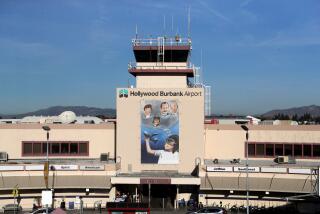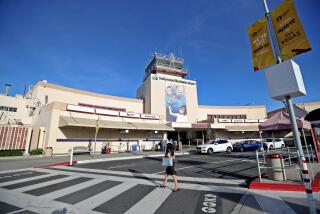A Headwind of Hostility : Burbank council, airport panel must face facts
Doomsday scenarios seldom come true, but here is one for the Burbank Airport:
The Burbank City Council blocks the construction of a new terminal building located safely away from runways. In response, the Federal Aviation Administration imposes rules that drastically shorten the usable runways--and end commercial jet flights.
Why raise such a specter? Because the past four months have turned the world upside down for the Burbank-Glendale-Pasadena Airport. Instead of a hostile Los Angeles, it now has to worry about a hostile Burbank City Council. Although there is no widespread sentiment against the mere relocation of the terminal, relocation till now has been linked with expansion, which is in serious trouble.
The turnaround came just as years of delay seemed to be over. In December a court cleared the way for the much-needed new terminal.
Then came the City Council race and the Feb. 28 election. Seven of 10 candidates crowded onto a bandwagon of opposition to a bigger terminal and the increased flights, takeoff noise and car traffic they glibly associated with it. The council to be seated May 1 will be dominated by expansion foes regardless of the outcome of a runoff Tuesday.
Obviously the Burbank Airport Authority must realize it cannot exist in a state of war with its host city and one-third owner. It has to work with the council on the complex issues involved and repair any damage caused by its haste to authorize bonds with the old council still in office.
But the critics must face facts too.
The airport is not just a nuisance to people who have chosen to live near it. It is a major economic asset. Its presence is attractive to business and convenient to travelers. The Valley and foothill communities to the east would be poorer without it.
The airport has not ignored the noise problem. It negotiated with airlines and got quieter jets. It is soundproofing four schools. It has arranged a voluntary curfew on flights early in the morning and late at night. Its plans for a terminal with five more gates are modest and sensible.
Airport officials point out that the number and times of flights are not strictly determined by the number of gates--there is plenty of gate space between peak hours now--and ultimately are controlled by airlines. Critics may question whether this is the last word on the subject, but they cannot ignore it.
The new council needs to take a businesslike approach recognizing that the airport is a valuable asset and that the three-city Airport Authority runs the facility, not the council. It could start by shelving a puckish campaign proposal to make living under the airport’s flight path a requirement for being among the three members of the authority that the council appoints.
Nor should the council assume that the election is a mandate to mount a full-scale attack on the airport. A professional poll in Burbank in December showed 2-1 support for a larger terminal. The election proved only that candidates thought the airport was unpopular. The reality is more complex than that.
More to Read
Sign up for Essential California
The most important California stories and recommendations in your inbox every morning.
You may occasionally receive promotional content from the Los Angeles Times.










